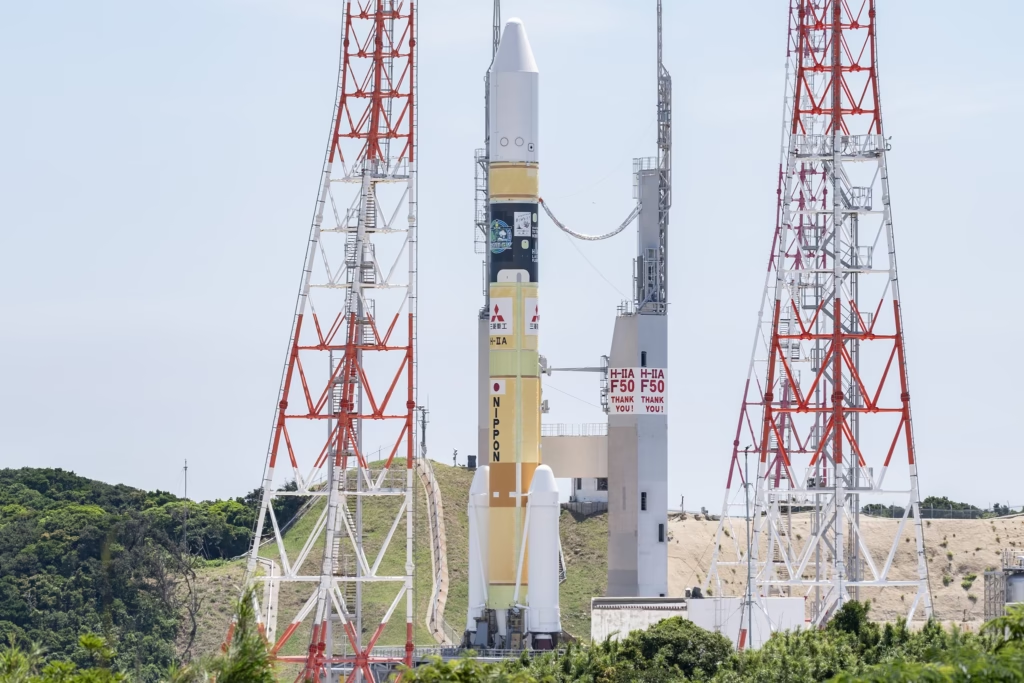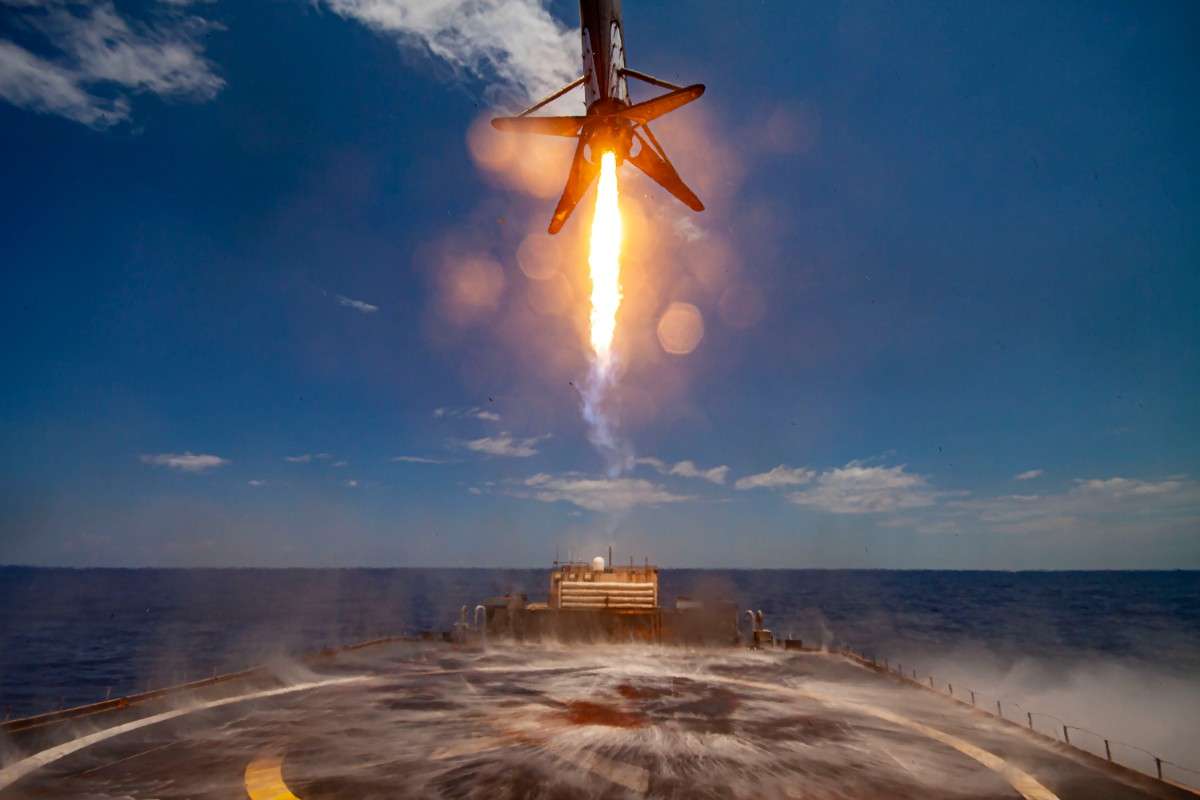Japan’s H2A rocket completes its final mission with a flawless launch, ending a two-decade legacy of precision, reliability, and technological excellence in space exploration.h

Japan’s H2A Rocket Retired After Successful Final Launch:
On a historic day for Japan’s space program, the H2A rocket completed its final mission with a flawless launch, closing a remarkable chapter in the nation’s aerospace history. Operated by Mitsubishi Heavy Industries (MHI) in collaboration with the Japan Aerospace Exploration Agency (JAXA), the H2A has been the backbone of Japan’s space launch efforts for over two decades.
The final flight, designated H2A F47, lifted off from the Tanegashima Space Center, carrying a government-owned reconnaissance satellite into orbit. With this mission, the H2A ends its operational life boasting one of the highest success rates of any rocket program in the world. Its retirement signals the arrival of a new generation of Japanese launch vehicles, including the more powerful H3 rocket, intended to meet future space exploration and commercial demands.
The Final Launch: A Seamless Farewell
The H2A F47 mission proceeded with the precision and reliability that have come to define the program. At the scheduled time, the vehicle’s LE-7A main engine and two solid rocket boosters ignited, sending the rocket soaring into the sky above southern Japan. Within minutes, it passed through maximum aerodynamic pressure and continued on a flawless trajectory.
After booster separation and main stage burnout, the upper stage ignited, precisely inserting the satellite into its intended sun-synchronous orbit. Confirmation of payload deployment came shortly afterward, and mission control at JAXA confirmed the mission’s complete success.
This final flight was not just another routine launch. Engineers, scientists, and spectators acknowledged it as a celebration of the H2A’s consistent performance, engineering excellence, and legacy of national pride.
Japan’s H2A Rocket: Origins and Evolution
The H2A rocket was developed as a successor to the H-II, which had suffered reliability issues and was deemed too costly for competitive commercial operations. The development of the H2A began in the late 1990s under the leadership of NASDA (National Space Development Agency of Japan), which later became part of JAXA.
Mitsubishi Heavy Industries took over launch operations in 2007, transforming Japan’s space launch model into a public-private partnership. This move was part of a broader national strategy to make Japan’s space program more competitive and cost-effective.
The H2A was designed to be modular, with configurations ranging from two to four solid rocket boosters and up to four solid strap-on motors, allowing the vehicle to carry a variety of payloads to different orbits. Its versatility enabled it to launch satellites for Earth observation, weather monitoring, communications, and scientific research.
Japan’s H2A Rocket: Technical Specifications
The H2A is a two-stage, liquid-fueled launch vehicle. The first stage is powered by a single LE-7A engine, which uses liquid hydrogen and liquid oxygen as propellants. The second stage uses an LE-5B engine, also powered by the same propellants, ensuring high efficiency and clean combustion.
Key specifications include:
- Height: Approximately 53 meters
- Mass at Liftoff: Around 445 metric tons
- Payload to Low Earth Orbit (LEO): Up to 15,000 kg
- Payload to Geostationary Transfer Orbit (GTO): Around 6,000 kg (depending on configuration)
The vehicle’s advanced guidance and navigation systems provided high-precision orbital insertions, making it ideal for sensitive and valuable payloads.
Japan’s H2A Rocket: Legacy of Reliability
The H2A rocket has launched 47 times, with 46 successes and only one failure, resulting in a 97.8 percent success rate. This makes it one of the most reliable rockets in operation during its time. The lone failure occurred in 2003, when a second-stage separation issue caused the mission to be aborted.
This high level of reliability earned the H2A trust not only from Japanese government agencies but also from international customers. The rocket launched satellites for South Korea, the United Arab Emirates, and the United States, including several missions for NASA and the U.S. military.
The H2A was also responsible for launching some of Japan’s most prestigious missions, including the Hayabusa asteroid sample return mission, the Akatsuki Venus probe, and the Himawari weather satellites. Each of these missions showcased Japan’s capability in space science and technology, cementing the H2A’s role as the workhorse of Japanese aerospace achievements.
Japan’s H2A Rocket: Significant Missions
Over its two-decade career, the H2A has supported numerous landmark missions:
- Hayabusa (2003): A pioneering mission to return samples from asteroid Itokawa, launched aboard H2A F6.
- Akatsuki (2010): Japan’s first Venus orbiter, launched on H2A F17.
- Himawari-8 and 9 (2014 & 2016): Advanced geostationary weather satellites supporting Japan’s meteorological capabilities.
- IGS Series: A range of information gathering satellites for national security and disaster monitoring.
- UAE’s KhalifaSat (2018): The first entirely Emirati-designed satellite launched by a Japanese vehicle.
These missions illustrate the broad utility of the H2A platform across science, defense, environment, and international cooperation.
Japan’s H2A Rocket: The Rise of the H3 Rocket
With the H2A’s retirement, Japan turns its focus to the H3 rocket, a more powerful and cost-effective launch vehicle designed to compete on the global commercial launch market. Developed by MHI and JAXA, the H3 aims to provide more flexible launch configurations, lower costs per kilogram, and improved manufacturing timelines.
The H3 uses an entirely new first-stage engine, the LE-9, which builds on the technology of the LE-7A but is designed for greater simplicity and manufacturability. The rocket will support multiple configurations (H3-30, H3-22, etc.) to match mission requirements.
Despite early delays and a failed first launch in 2023, the H3 has since returned to flight and is expected to gradually replace both the H2A and H2B vehicles. The move reflects Japan’s strategy to maintain its independent access to space while expanding its presence in the international space economy.
Japan’s H2A Rocket: Strategic and Economic Impact
The H2A rocket played a crucial role in Japan’s national space policy. It enabled Japan to launch domestic satellites without relying on foreign rockets, strengthening national security and strategic autonomy. It also supported the country’s scientific and environmental goals, enabling high-quality data collection and monitoring of natural disasters.
Economically, the rocket’s long-term service helped build a robust aerospace industry ecosystem involving manufacturers, research institutions, and service providers. The commercial division under MHI attracted foreign customers and demonstrated that Japan could compete in the global launch market, even with fewer flights per year than larger players like the United States, Russia, or China.
The transfer of operational control from JAXA to MHI marked a significant shift toward commercialization, positioning Japan as a serious contender in the evolving landscape of private space launch services.
Japan’s H2A Rocket: Environmental Considerations
The H2A’s use of liquid hydrogen and liquid oxygen meant that its exhaust was primarily water vapor, a cleaner alternative compared to rockets that rely on kerosene or solid propellants. This design aligned with Japan’s broader environmental policies and commitment to sustainable technological development.
Although launch vehicle production and operations inevitably involve resource consumption, Japan’s approach has been to balance innovation with environmental stewardship. The lessons learned from the H2A program are expected to inform the design and operations of future launch vehicles, including the H3.
https://x.com/japantimes/status/1939515502793220455?t=xceWORRfbnG0IsqfSI_kWA&s=19
Japan’s H2A Rocket: The Global Context
In the context of global space launch vehicles, the H2A stood as a symbol of quiet excellence. While it did not launch as frequently as SpaceX’s Falcon 9 or China’s Long March series, it maintained a reputation for reliability and precision.
Japan’s role in the space industry is unique: it balances strong domestic needs with a moderate but significant commercial presence. The success of the H2A contributed to international confidence in Japanese aerospace capabilities, and the nation is often seen as a trusted partner in multilateral space collaborations, including missions with NASA, ESA, and other Asian space agencies.
Japan’s H2A Rocket: Conclusion
The retirement of the H2A rocket marks the end of an era, but not the end of Japan’s ambitions in space. Over 20 years of operations, the H2A served as a foundation for national pride, technological achievement, and international cooperation. With its final mission completed successfully, it leaves behind a legacy that future rockets like the H3 will build upon.
As Japan enters a new phase in its space journey, the story of the H2A will be remembered as one of discipline, reliability, and quiet leadership in the global arena. The final launch was not merely a technical success—it was a farewell salute to a trusted workhorse that carried Japan’s dreams to the stars.
What Is Rocket Labs Symphony In The Stars ? Everything About Today’s Big Launch
Japan’s H2A Rocket: FAQs
Q1. What is the H2A rocket?
The H2A is a two-stage, liquid-fueled launch vehicle developed by Japan’s JAXA and Mitsubishi Heavy Industries. It was designed for satellite launches and interplanetary missions and operated for over two decades.
Q2. When was the H2A rocket first launched?
The first launch of the H2A rocket took place on August 29, 2001, from the Tanegashima Space Center in Japan.
Q3. What was the purpose of the final H2A launch?
The final H2A launch, designated H2A F47, carried a Japanese government reconnaissance satellite into orbit. It marked the end of the H2A’s operational career.
Q4. How many times was the H2A rocket launched?
The H2A was launched 47 times, with 46 successful missions and only one failure, giving it a 97.8% success rate.
Q5. Why is the H2A rocket being retired?
The H2A is being retired to make way for Japan’s next-generation launch vehicle, the H3 rocket, which offers improved cost-efficiency, performance, and flexibility for future missions.
Q6. What were some of the most important missions launched by H2A?
Notable missions include the Hayabusa asteroid sample return, Akatsuki Venus orbiter, Himawari weather satellites, and international payloads such as UAE’s KhalifaSat.
Q7. What will replace the H2A rocket?
The H3 rocket, developed by JAXA and Mitsubishi Heavy Industries, is designed to replace both the H2A and H2B launch systems.
Q8. What are the key technical features of the H2A rocket?
The H2A uses liquid hydrogen and oxygen propellants, a modular design for varying payload needs, and advanced guidance systems. It stands about 53 meters tall and can carry up to 15,000 kg to low Earth orbit.
Q9. Did the H2A launch any international satellites?
Yes, the H2A launched satellites for countries including South Korea, the United Arab Emirates, and the United States, including payloads for NASA and the U.S. military.
Q10. What is the legacy of the H2A rocket?
The H2A is remembered for its exceptional reliability, technical precision, and contributions to Japan’s space independence and international collaborations. Its retirement marks the end of a successful era in Japanese aerospace history.

